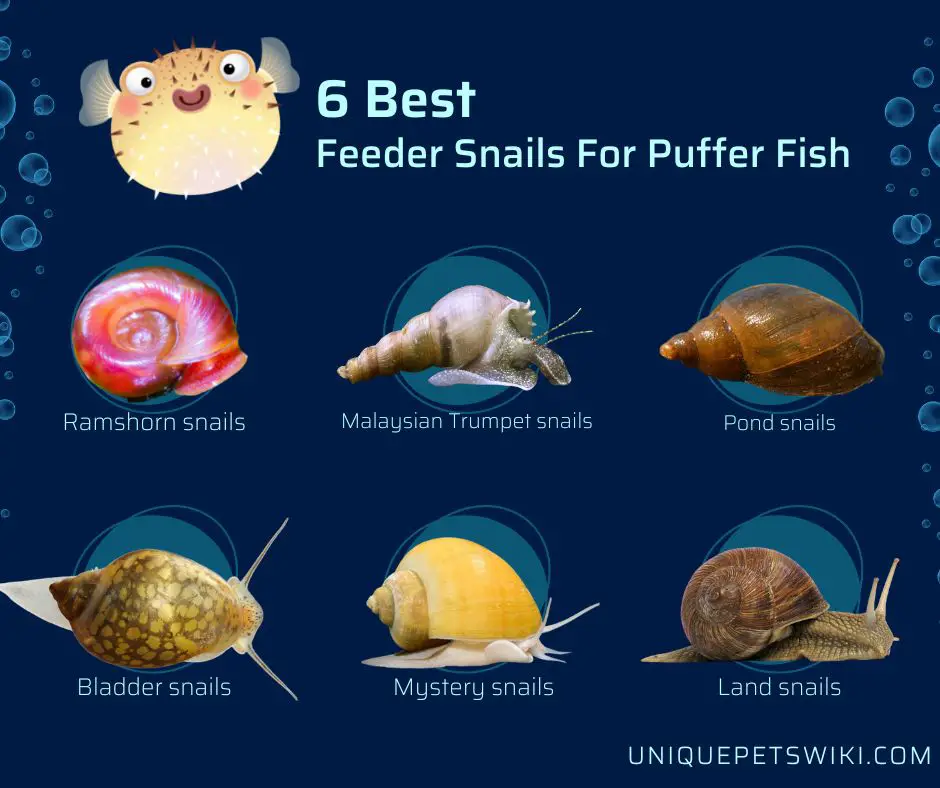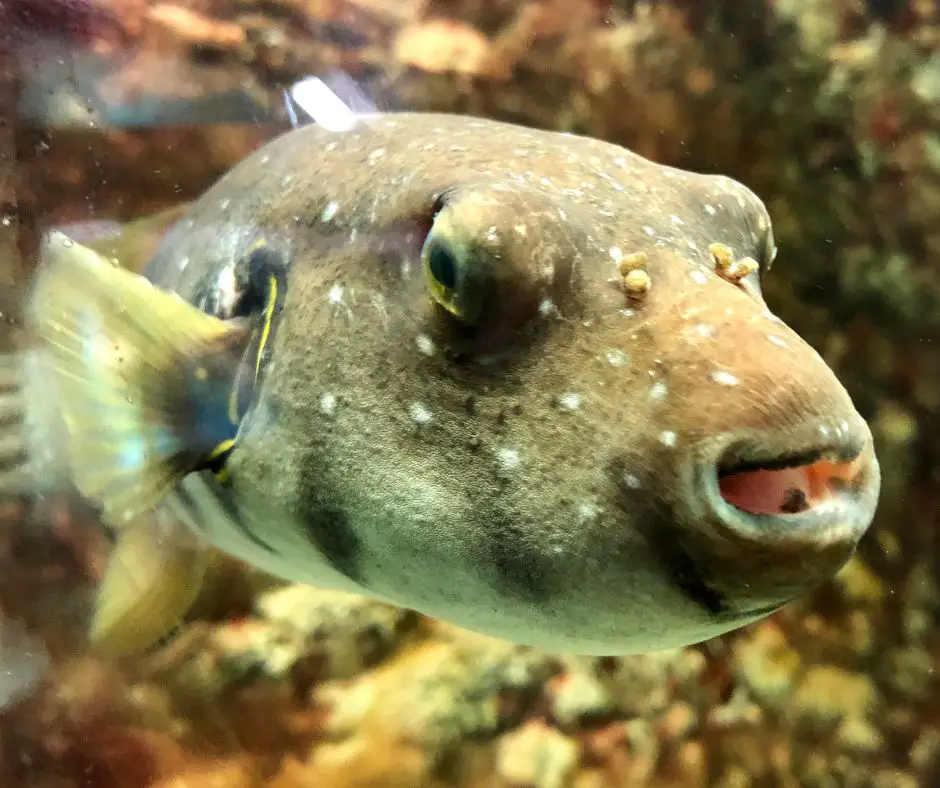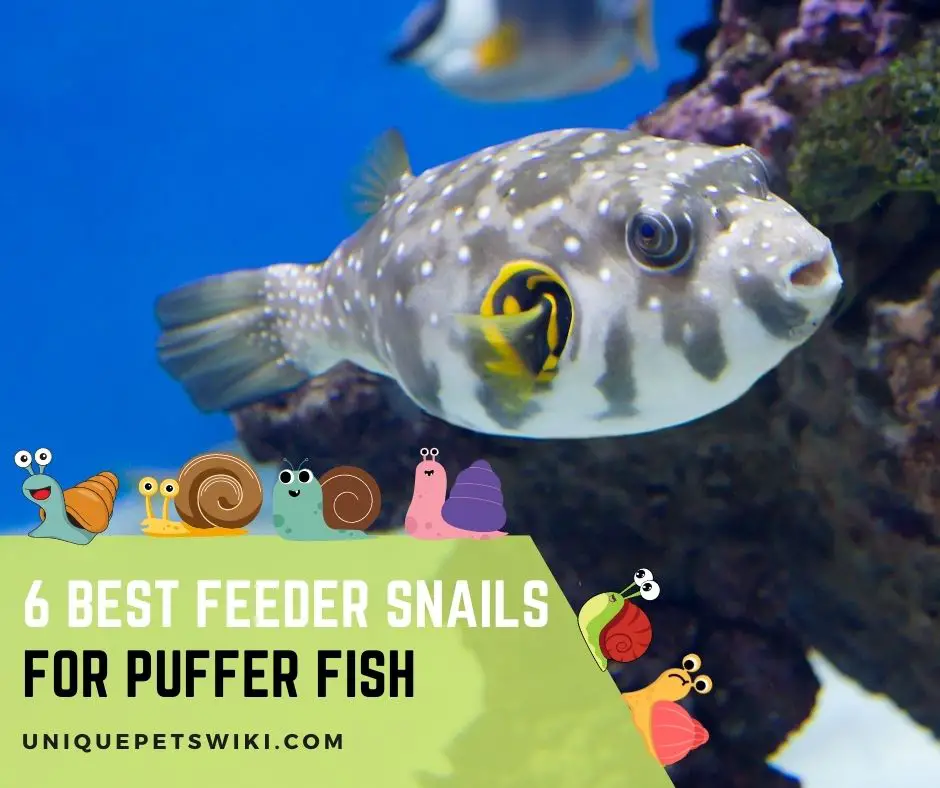This article details the 6 best feeder snails for puffer fish, how to breed them at home, and some do’s and dont’s to observe when feeding them to your pets.
For your puffer fish to have the best health and live for the longest time possible, their nutrition has to be well-balanced, and snails play a big role in this.
Based on the species of puffer fish you keep, you will learn how to approach the aspect of feeding snails to your pets, even as a first-time fish-keeper.
Contents
Can You Feed Puffer Fish Snails?
Yes. Snails are an important delicacy to puffer fish, providing a diverse range of nutrients like iron and calcium to them.
Even in their natural habitats, puffers feed on snails which help their immunity and overall skeletal development.
6 Best Feeder Snails For Puffer Fish
While snails are a critical component of puffer fish diets, not all species are ideal for your pets. It is important to know the snails to feed to your puffer for the best nutritional advantages and to avoid causing them any dangers.
In this regard, the 6 best feeder snail species for puffers are ramshorn, Malaysian trumpet, mystery, land, pond and bladder snails.

Ramshorn Snails
These snails have a shell elongated like a ram’s horn, which is where it draws its name from. They are fairly small in size, with bodies averaging about 1 inch in diameter.
Given their ideal sizes as feeder snails and the fact that they are easily found in many pet stores, ramshorn snails are a convenient option to many puffer fish owners.
In terms of their pricing, at around $15, you can get a set of at least ten ramshorns, though there may be slight variations depending on the pet store.
Malaysian Trumpet Snails
These snails are known for their hard, and thick, conical shells. While this feature causes concern to many puffer fish owners, the reality is that puffers have teeth suited for eating molluscs.
Smaller-sized puffers tend to suck the snails from their shells if their beaks cannot break them in.
These snails are therefore good for the management of the teeth of your puffers. In addition, if introduced to the aquarium alive, they may help keep it clean for the duration of time they are not fed upon by the puffers.
This is because they feed upon algae and other plant wastes which may upset the water’s pH balance.
Pond Snails
While they have a reputation for reproducing pretty fast and sometimes overcrowding a tank, pond snails are a good source of calcium and iron.
In addition, with their hard shells, they help to keep the teeth of puffer fishes trimmed and under control.
If you choose to breed these freshwater snails as feeds for your puffer fish, it is advisable to start with a few set of snails.
By strictly controlling the feed available to them in their tank, you will not have to worry about their overpopulation.
Bladder Snails
They are often referred to as pest snails for their ability to invade a tank with the addition of new plants, and then reproduce fast.
In spite of this reputation, bladder snails are a good addition to the diet of your puffers.
Furthermore, given their small, half-inch sizes, they are easily ingested by puffers.
When they are still young, their shells are rather soft, which makes them a convenient dish for smaller puffer fishes which may not have fully-developed teeth.,
Mystery Snails
These snails are widely available in pet stores and are commonly kept as pets in their own right.
They have fairly large shells with attractive colours and may grow to 2 inches or more if they are female.
For smaller-sized puffer fishes such as dwarf puffers, baby mystery snails make the best feeding option.
This is because they do not have to struggle with fully formed shells which characterize adult mystery snails.
Mystery snails are easy to rear even for a first-time breeder as they have few inhibitions on water requirements and the feeds availed to them.
They are a fairly cost-effective way to ensure that your puffers get adequate calcium in their diet.
Land Snails
Are a variety of snail species that live on land, and they come in different sizes and shell physiques. Some species, like the African breed can reach up to 20 cm in length.
They are also good for puffer fishes as their shells provide the trimming effects necessary for their teeth and are packed with calcium and iron. You may want to feed them to the puffers before they are fully developed.
Bad Feeder Snails for Puffer Fish
Most snails are beneficial to puffer fish, unless they’re uneaten for a long time and then reproduce very fast to overrun the tank. This may also imply that the puffer fish are overfed which may compromise their life expectancy.
Snails taken from polluted environments may also be harmful to your puffer fish. They may introduce toxic elements into your fish’s bloodstream and cause diseases.
Thus it is important to maintain a healthy breeding environment for your feeder snails or to buy them from reputable stores.
How often to Feed Puffer Fish Snails
While puffer fish will benefit greatly from a diet consisting of snails, the amount they are fed has to be controlled. These fishes may overfeed when lots of food is dropped into their tanks, hence the need to devise a proper feeding routine.
It is important to note that there may be slight variations in the ideal feeding frequencies of puffer fish, and this mostly depends on its specific species and its age.
Generally, these pets are best fed 1-2 times a day, and this also includes a variety of other foods alongside snails.
The puffer fish will likely have a distended belly after feeding, and if unsure, this could indicate when you should feed it next.
It may not be necessary to feed your puffer with snails every mealtime. Nevertheless, it is important to ensure that the fish doesn’t go more than a week without eating snails.

Where To Buy Feeder Snails?
You can buy feeder snails conveniently from pet stores near you, since they are reared both for feeding and as pets in their own right.
In physical stores, depending on the species of the snail, you will often get a number of snails selling for a predetermined price. Sometimes they are sold by the kilo.
Outlets such as Walmart and PetSmart have a variety of breeds to choose from, though it is easy to find them sold out. You could also try PetCo if there is a store near you.
Additionally, online stores also offer a convenient source of snails. Amazon, eBay, Wild Pet Supply and My Happy Snails are some online options.
You could also find individual sellers, often looking to reduce their snail populations by selling some away.
Generally, online options tend to be a little more pricey than physical stores, in part because of the shipping logistics that have to be catered for. In terms of the health and quality of snails, there is no sure way to be 100% certain.
Be sure to check out reviews of vendors from previous buyers to determine the services and quality of snails to expect.
How to Feed Puffer Fish Snails
Snails may be dropped directly into the tank for the puffer fish to prey on it and start eating it while still alive. This is the most common and ideal feeding method as it allows the snail’s teeth to be controlled.
You may also chop the snail up and drop its meat into the tank. This may be necessary for baby puffers or sick puffers whose abilities to crack the shells of snails are compromised.
How to Breed Snails to Feed Puffer Fish
Self-breeding of puffer fish portends a number of advantages, key amongst them the financial savings that you are able to make after the initial investment.
The convenience of having feeder snails when needed is yet another advantage.
The following general steps will come in handy when preparing to breed snails:
- Do sufficient research to determine the exact species of snails that you’d like to keep
- Get an appropriate terrarium with adequate space. A plastic or glass enclosure of at least 20cm long, 18cm wide, and 30 cm high is advised.
- Bigger dimensions may be appropriate depending on your future breeding plans
- Ensure the tank has proper ventilation and position it away from direct sunlight.
- Place substrate at the bottom of the terrarium, taking care to add soil and some pieces of rock. You should look to set up at least 2 inches of soil that is free from any chemicals or fertilizers
For land snails:
- If you will be breeding land snails, moist, loamy soils provide a close imitation of their natural habitats
- You may add a shallow container of water to the terrarium for the land snails to hydrate from
- Have a variety of foods ready: veggies like spinach, cabbage, lettuce and cucumbers; and fruits like oranges, peaches, plums and papaya.
- Plants like fungi, algae and decomposing vegetations are also a delicacy to them
- Snails are omnivores and can also eat small insects and animal wastes.
- You can now introduce your parent snails into the terrarium and wait for them to grow their population
- Note that snails are hermaphroditic, and some may reproduce asexually, while others require to be in pairs to lay eggs
Exo Terra Glass Terrarium Kit
- Glass terrarium for reptiles or amphibians
- Patented front window ventilation
- Raised bottom frame in order to fit a substrate heater and has a waterproof bottom
- Escape-proof dual doors lock to prevent escape
- Closable inlets for wires and/or tubing management
Last update on 2022-12-29 / Affiliate links / Images from Amazon Product Advertising API
Wrapping Up
Snails are a delicacy to puffer fish, and they offer immense nutritional advantages to these pets.
Their hard shells also offer a means for controlling the growth of the teeth, which may prove problematic if left to thrive freely.
Fortunately, snails are available in many pet stores, and can also be conveniently bred by a puffer fish owner. Land, Malaysian trumpet, pond, mystery and bladder snails are some ideal species to feed to puffer fish.
The choice of the ideal snail species to feed to your fish should be in part determined by the size of your puffer fish.
Nevertheless, it is also important to regulate the intake of your puffer fish. As they don’t easily control their own feeding, oversupplying them with snails may easily lead to overfeeding.

